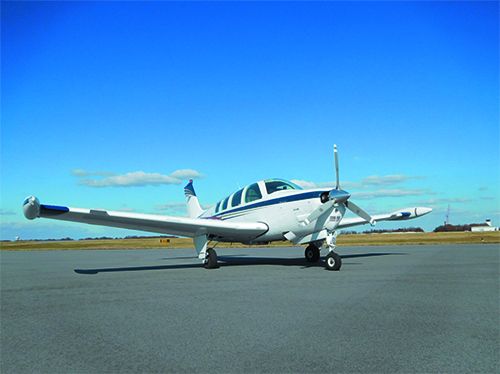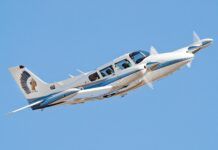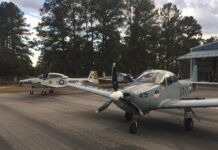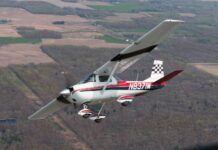For as long as we can remember there has always been a certain prestige that tags along with owning a Bonanza. We suppose that’s good and bad. On one hand, the Bonanza 36’s earned reputation as arguably one of the flagship GA complex singles (in good company with Piper’s PA46 Malibu, perhaps) might after all these years still boost the airplane’s retail value.
But when you roll onto the maintenance ramp with one don’t expect any sympathy. Moreover, service parts for Bonanzas and its multi-engine sibling (the Baron, of course) aren’t exactly priced for shoestring budgets. Keep all of the above in mind when considering stepping up to a Bonanza.
With that out of the way, we think the right used 36 Bonanza will likely be one of the most satisfying singles to own and fly. Load it heavy, fly it far and install some performance-boosting aftermarket mods.
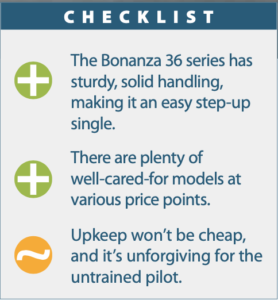
HISTORY
In one form or another, the Bonanza has been in continuous production since 1947, when the first V-tail was built—an astounding fact in itself. The 35 Bonanza was the first high-performance postwar single and was markedly different from the average light airplane of the day. Base price of the first models was $7975 ($58,943 in 2020 dollars).
By 1967, Beech had a gaping hole in its model lineup. Archrival Cessna had been selling its six-place retractable single, the 210, since 1960 and by the end of the 1967 model year had rolled 936 through the factory doors. Cessna also had the 206 for the utility market.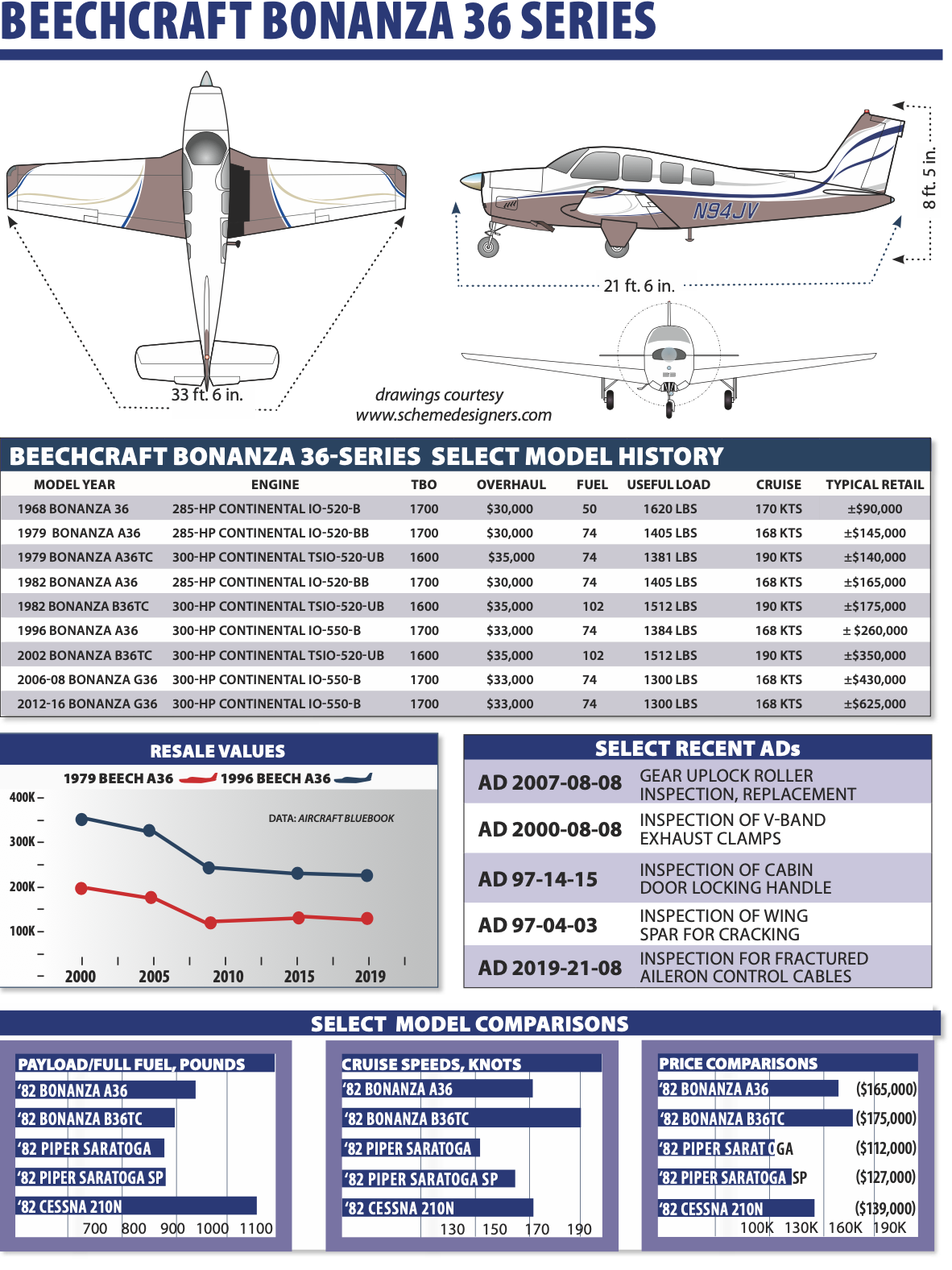
Beech didn’t have a truly comparable airplane. The V-tail, S35 Bonanza, introduced in 1964, received a 19-inch cabin stretch that permitted the installation of a fifth and sixth seat. These were called “family” seats, and they really weren’t suitable for adults. The company kept working on a true six-place airplane.
For the 1968 model year, Beech introduced a stretched version of the Bonanza, with six seats, a conventional tail like that on the eight-year-old Debonair (redubbed 33 Bonanza that same year) and an aft set of doors. Base price of this first 36 Bonanza was $40,650, which rose to an average of $47,050 equipped ($347,748 in 2020 dollars). That same airplane is now worth an average of $90,000.
The original 36 was equipped with a six-cylinder Continental IO-520-B engine producing 285 HP and swinging a two-blade prop. It had some limitations compared to the later models: Club seating was not yet available and the standard fuel capacity was only 50 gallons, with 80 optional.
The stretch was accomplished by adding 10 inches to the fuselage of a 33 Bonanza; the 36 was not an all-new airplane. The length was added in such a way that the cabin moved forward, relative to the wing. Empty weight rose only 31 pounds.
The 36 was aimed at the utility and charter market dominated by Cessna, as a good choice for air taxi and cargo hauling. This was in contrast to the V-tail Bonanza, which was sold as an upscale business airplane. The 36 Bonanza could even be flown with the rear doors removed. Of course, the original 36 could be outfitted with options like a more plush interior. In 1970, the A36 debuted with the popular club seating option. The marketing focus changed, positioning the A36 more as a larger version of the other Bonanzas rather than as a utility airplane. Many of the “luxury” options became standard equipment.
In 1973, the fuel system was changed. Standard capacity actually went down to only 44 gallons, with a 74-gallon extended range system available. We believe it’s highly unlikely that there are any standard-capacity A36s in the fleet. An 80-gallon system was made standard in 1980.
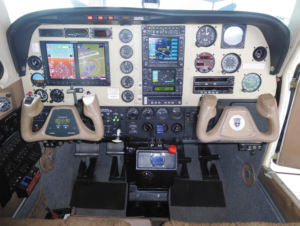
As the years passed, the basic A36 remained largely unchanged, though in keeping with its real-world mission—a personal user’s IFR platform—more and more equipment was made standard. By 1976, an autopilot was standard, along with what is now a basic IFR suite.
Responding to the call for turbocharging, Beech introduced the A36TC in 1979. With a 300-HP Continental TSIO-520-UB, equipped with a variable absolute pressure controller that automatically maintained manifold pressure during altitude and temperature changes, the airplane showed a lot of potential. Only 272 were sold in three years, as pilots complained about having only 74 gallons of fuel aboard when the engine wasn’t exactly fuel efficient.
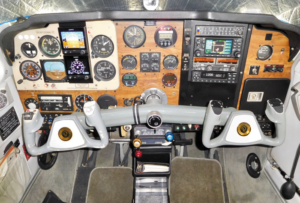
In 1982 Beech released the B36TC, which used the Baron 58 wing. It was longer, for better performance at altitude, and carried 102 gallons of avgas. The changes punched up range by 50 percent.
The biggest change to the normally aspirated airplane came in 1984, when a 300-HP Continental IO-550 replaced the IO-520. There was an all-new (and very well laid out) instrument panel. Gone was the trademark Bonanza “throwover” control wheel with its massive central column in favor of a pair of ordinary control yokes. With the introduction of this airplane, the base price had roughly quadrupled over the original 36: $160,700 ($397,818 in 2020 dollars) with a current average value of $155,000.
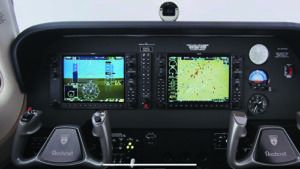
The bigger engine can be retrofitted to older aircraft; a popular mod, judging by our reader feedback. TBO on all of the engines that have gone into the “straight” (non-turbo) 36 Bonanzas is 1700 hours, with the estimated overhaul cost on the 520 currently at $30,000 or so and $33,000 for the 550. An owner opting to switch rather than overhaul not only gets the extra power (for not a lot more fuel burn), but better service reliability as well.
The current G36 (G for Garmin 1000 glass panel) Bonanzas are the only Beech singles still in production; the last F33As were built in 1994.
PERFORMANCE AND HANDLING
This is why pilots love Bonanzas. The handling for its intended mission is just about as good as it gets, although the 36 is regarded as more ponderous than the sports-car-like V-tail 35. This is due mostly to the stretched fuselage, although that has its advantages over the 35 when it comes to weight and balance.
The somewhat higher control forces are also a safety feature in that they translate directly to rock-solid stability—desirable in an IFR platform. An airplane with relatively high stick-force-per-G control forces is less likely to depart into a spiral if the pilot has to divert attention for a moment or two from the task of keeping the airplane upright and on course. That’s very important in slick, fast singles, as loss of control in IMC causes a significant number of accidents.
Landing is much easier than in some airplanes, although at extreme forward CG loadings (common when flying solo), it requires some determination to raise the nose in the flare and make a smooth landing. Use the electric pitch trim. Still, unlike earlier research we did on the airplane’s accident record, we were impressed to find few runway loss of control incidents on landing. But keep your guard up—too much speed on touchdown can be a setup for an overrun or loss of control on rollout.
One characteristic of the classic V-tail that is blessedly reduced in the 36 models is the notorious tendency to Dutch roll in turbulence. The extra length makes for a more comfortable ride and many straight-tail Bonanzas have a yaw damper system, which makes it even more steady.
In keeping with its mission as a serious cross-country machine, performance is respectable. Cruise for the normally aspirated 36 and A36 is about 165 knots, with a 1000 FPM-plus initial climb rate. The A36TC and B36TC will keep up with a Mooney 231 and Cessna T210N, running in the 170- to 180-knot range in the middle altitudes. Once over 20,000 feet, the longer wing of the B36TC shows itself, making the airplane a few knots faster than the A36TC, with cruise speeds in the area of 190 knots. That’s not bad, but there’s a price to pay.
Fuel burn for the turbos is high, at least 17-18 GPH, to keep head temps under control.
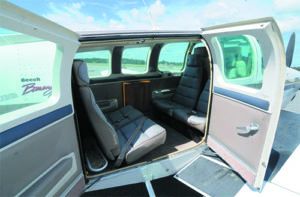
CABIN AND PAYLOAD
The 36 has excellent visibility and is quite comfortable, although headroom and legroom is cramped for taller pilots and passengers. With four aboard, it’s a luxury liner, but adding a fifth and sixth person makes things tight. There is a noticeable shortage of baggage space. Some room aft of the third row of seats (watch that CG envelope) was created with the 1979 model. Before that, the only place to stow things was the modest slot between the front seats and the rear-facing center row. There is not enough room to fit six people and six bags on board, a problem for a family that has kids and needs space for stuff.
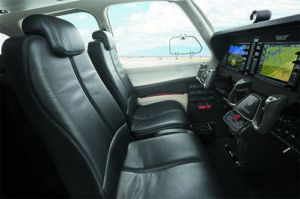
Up front, the panel is generally well organized, although at the time the earlier 36 Bonanzas were made, Beech was still using the “backward” or “airline” positioning of the gear and flap switches with gear on the right and flaps on the left. It wasn’t right or wrong, but just different. But it has led to many inadvertent gear retractions. We do this: When clearing the runway and cleaning up the airplane, don’t touch the handle until you verify (verbally call it) it’s the flaps you’re about to raise. Later models have the switches placed as they are in other airplanes.
When loading the 36, figure on about 950 pounds in the cabin with full fuel in an A36, but watch the aft CG limit when carrying passengers. The A36TC is not a great load hauler; full fuel cabin load is 700-800 pounds. With six 170-pounders in the cabin, each with 20 pounds of luggage, it is not possible to put any fuel in the tanks and be under gross weight.
The B36TC had a higher empty weight than the A36TC, but gross weight went up by 200 pounds, a net improvement of about one 170-pound passenger. Plan on being able to carry 900 pounds in the cabin with full fuel.
CRASHWORTHINESS
Beech paid attention to crashworthiness and survivability, providing a strong “keel” arrangement from the aft end of the cabin to the nose. It’s tied into a sturdy rollover structure that provides anchor points for shoulder harnesses for all occupants (four-point style for the front seats). There are openable side windows that function as emergency exits. There is no separate door or exit for the pilot. The fuel tanks are in front of the main spar, which lessens their protection in a crash and means that the center of gravity moves aft as fuel is burned.
The gear is massive. It’s the same landing gear used for the Baron, where it has to support far more weight. The military T-34 trainer is basically a Bonanza, and as a result the gear had to be subjected to severe drop tests to satisfy the Pentagon. All that structure underneath the cabin also helps to absorb impact forces in a crash.
Another nice thing about the gear is that it’s electromechanical and, if correctly maintained, has proven reliable. Emergency extension is through a simple hand crank located behind the front seats.
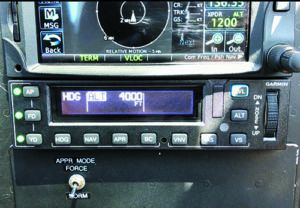
The 36 Bonanza also has a simple feature lacking in many aircraft: an easy-to-open “barn door” cowl, making preflight of the engine easy. This is really a safety feature, in our opinion. A popular mod is seatbelt airbags from AmSafe.
The 36 Bonanzas have a much longer CG range than the Model 35 series, although not as long as its competitor, the Cessna 210. Both fore and especially aft loading have to be carefully watched. A pilot flying solo with a full fuel load might have difficulty getting the CG aft of the forward limit. Trying to carry six passengers (reduced fuel is necessary) and any baggage aft of the rear seats may not be possible.
MODS AND CLUBS
Unlike the V-tail, the 36 Bonanzas (G36, for the Garmin G1000 integrated avionics) being built today are very similar to the first ones off the line: The biggest difference is the engine. As a result, there aren’t quite as many mods as for the smaller airplane, though the list is still a healthy one. Too many to list, but here are a few popular ones.
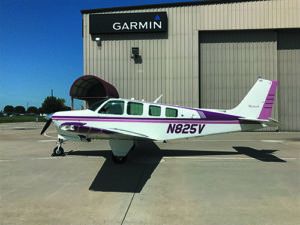
As noted above, upgrading the IO-520 to the IO-550 is a popular option when it comes time to overhaul. The STC is available from a wide variety of sources. We have been particularly impressed with Tornado Alley Turbo’s (www.taturbo.com) turbonormalization mod for the A36 that adds 400 pounds to the gross weight and makes the airplane capable of carrying four people 1000 miles at 200 knots.
Owners of two-blade props can upgrade to the three-blade airscrew from Hartzell at (www.hartzellprop.com). Also available are various speed mods and even vortex generators.
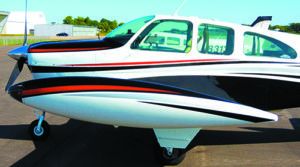
But hang around a Bonanza hangar and you’ll hear the name D’Shannon Aviation. Its Raw Power engine conversion kits gives the airplane a serious shot in the arm. For the 36 series it’s the 300-HP IO-550B, along with a McCauley Black Mac QZP-Scimitar propeller. The company also owns gross weight increase (GWI) STCs to bring the 36-series airplanes to 3850 pounds. All 1983 and previous models need to have the IO-550 STC and baffle cooling kit to qualify for the 3850-pound GWI. All 1984 and later A36 and G36 models don’t need any upgrades for the GWI. D’Shannon’s tip fuel tanks increase the gross to 4010. The company also has a high-performance exhaust kit for IO-550, IO-520 and IO-470N Bonanzas. There are also gap seals, vortex generators and new instrument panels. Visit www.d-shannon-aviation.com for a wealth of available mods and their performance gains.
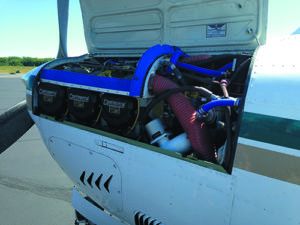
Arizona-based AmSafe has STCs for seatbelt airbag systems for the Bonanza and you can find more information at www.amsafe.com. We looked at them in the June 2017 Aviation Consumer.
Approach Aviation (www.approachaviation.com) markets its SmartSpace baggage conversions for pre-1979 airplanes. It gives a much-needed eight cubic feet of baggage area behind the rear seats, with a 70-pound capacity, while retaining the rear hat shelf. Installation is reported to take only a day.
The best source of current information about mods is the American Bonanza Society. It offers service clinics, training clinics, fly-ins and a good magazine. The ABS is located in Wichita, Kansas (where else?). Find them at www.bonanza.org. In our opinion, we would not own a Bonanza without being a member of the ABS, and neither should you.
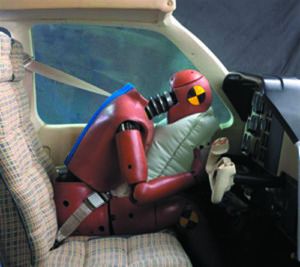
MARKET REALITIES
Scanning the current used market for the 36-series Bonanza, we found prices all over the place depending on mods—especially engine mods. Our go-to starting point reference, Aircraft Bluebook, says a 1994 A36, as one example, might retail for around $245,000. Backstopping that with the popular used aircraft website www.controller.com, we found that $300,000-plus asking prices are more realistic in the current market. Ones with the latest and greatest retrofit avionics, plus posh interior and nice paint, fetch even more money.
We found a good number of turbine Bonanzas on the market. These are the ones modified (by Tradewind Turbine Conversions) with the 450-HP Rolls-Royce Allison jet prop engine. We found a 1994 model with 2300 hours total time and 1795 hours (since new) on the engine priced at $500,000. Another with 143 hours since a hot section was priced over $600,000.
The latest Bonanza from Textron Aviation is the G36 and you’ll pay dearly for a new one and even an earlier one. For example, a 2007 60th Anniversary Edition G36 with 1100 hours total time (airframe and engine), WAAS G1000 avionics, no damage, factory oxygen, ADS-B Out and a Tornado Alley turbonormalized mod is priced at $519,000.
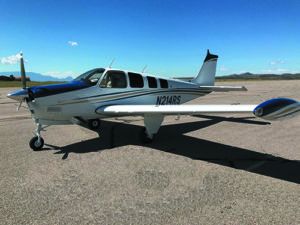
No matter which Bonanza suits you, do a thorough prepurchase evaluation and pay particular attention to the performance of the autopilot, especially earlier King KFC150/200 and Century-equipped models. Look for pitch oscillations and pay close attention to approach coupling. The autopilot is an important system in a Bonanza and maintenance to these older systems can be pricey and time consuming. Garmin recently earned an STC for its GFC 600 retrofit autopilot. We flew it last year in the company’s A36 flight test airplane and it flew the airplane like it was on rails. But you’ll pay a hefty price for such performance and integration. For the right Bonanza we think it’s worth it and a better long-term solution than paying to maintain an old King or Century system.
OWNER COMMENTS
I have a 1988 B36TC and I think it fits the high-performance piston single spot well. I live at 8000 feet in Colorado and often cross the mountains at 13,500 or 14,500 feet, or above, so the turbo engine is useful. It will climb 1000 FPM, even in the teens, and the ceiling is 24,000 feet. Cruise is 170 knots true at a modest power of 28 inches and 2300 RPM at 18 GPH, at 11,500 feet. More power, up to 31 inches at 2400 RPM, gives more speed and probably 200 knots true at 20,000 feet.
Pros: interior room and a feel of quality overall. Holds 108 gallons fuel, so range is longer than I can sit. Nice handling in cruise, stronger than some planes, rated utility category.
Cons: the Continental engine, problems with exhaust valves mainly—once had zero compression since the valve face was missing a pie-shaped piece, and had a cracked case.
Two points to know on the B36TC: If not properly rigged and closed, the door can pop open just at liftoff. No problem, but the noise is like a firecracker and can scare the pilot into doing something dumb. Do it on purpose on the initial checkout and learn.
It comes new with six seats. If you don’t want two people to have to ride backward, you can turn the middle seats around to face forward. It is easy if you read the pilot manual on how to do it. I removed my rear seats and use that area for baggage room.
Bill Greenwood via email
I bought a 1977 A36 (N214RS) this last spring after owning a V35A for a number of years. My new airplane has D’Shannon 20-gallon tip tanks, an IO-550 engine upgrade and other mods that allow a gross weight increase to 4000 pounds.
I can highly recommend the American Bonanza Society to other Bonanza/Baron owners. The ABS is an extremely valuable source of information for everything Bonanza.
Ralph Scargall – Santa Fe, New Mexico
We acquired our A36 after selling our previous bird, an A35 Bonanza, due to our family having outgrown it. Both aircraft are from the same lineage, and because of that they share the same wonderful flying qualities for which the Bonanza is so well known. But, there is an extra 1000 pounds on the wing in the 36 and you feel it in the controls. In short, flying the A36 is like flying a truck when compared to the A35.
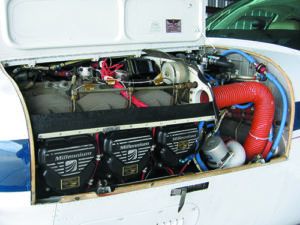
While the controls are heavier, they aren’t objectionable, and the extra weight also makes for a much more stable platform. I found that to be the only issue in transitioning from our old Bo.
We routinely true out at 155-160 knots at 10,000 to 11,000 feet. Fuel burn with a stock IO-520 engine at our normal cruise of 20 inches and 2300 RPM averages about 12 GPH. We installed GAMIjectors, and that reduced cruise fuel flow to about 10.5 GPH. Speaking of GAMIjectors, that, in my opinion, is the single best mod any Bonanza owner can do to their aircraft.
The airplanes are solid, reliable machines. For family travel they really have no competition; they are in a class by themselves. They’re great to fly, have no nasty handling quirks and are super comfortable for long flights.
Chris Nichols via email

